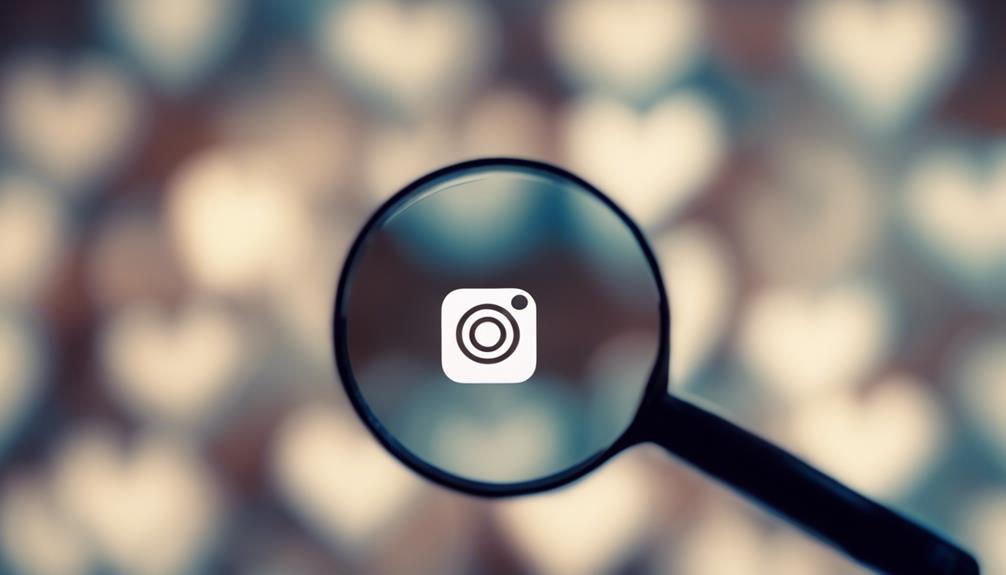
Can you look up someone’s Instagram likes?
Did you know that Instagram, with over a billion users, removed the ‘Following’ tab in 2019, thereby greatly limiting your ability to see what posts others are liking? It’s a change that has sparked debates about privacy, user behavior, and the very nature of social media interaction itself. You might be wondering if there’s still a way to decipher someone’s Instagram likes. Well, it’s a complex issue, steeped in ethical implications and privacy concerns. Stick around, as we’re about to navigate these murky waters.
Key Takeaways
- Instagram’s privacy policies prevent the direct tracking of someone else’s likes due to data protection laws.
- Instagram removed the ‘Following Tab’, which previously displayed users’ likes, due to privacy concerns.
- Despite the removal of likes visibility, users can still see their own likes and interactions on their posts.
- Third-party applications offering insights on likes should be used cautiously, as they require user consent and may risk data privacy.
- Instagram Stories and Direct Messaging are alternative ways to track engagement and interactions on the platform.
Understanding Instagram’s Privacy Policies

To navigate the labyrinth of Instagram’s privacy policies, you’ll need to grasp how they govern the visibility of user likes and interactions. This understanding is integral for those seeking to innovate within the confines of social media.
Instagram, like any other platform, is bound by data protection laws. These laws mandate that user consent is essential before accessing or using personal data. That’s where Instagram’s privacy policies come into play. Instagram requires you to grant consent when you sign up, and this consent applies to the display of your likes and interactions.
However, Instagram’s privacy policies aren’t static. They evolve in response to shifts in data protection laws and user expectations. For instance, changes are often made to increase transparency and to give you more control over your data.
In essence, Instagram is continually innovating to ensure its policies align with legal requirements and user consent norms.
The Old Instagram Feature: Following Tab
Remember when Instagram had a ‘Following Tab’ feature? This tab functionality offered a unique peek into the actions of the people you follow. You could see their likes, comments, and followings. It was a hub of user interaction, providing a sense of connectivity among Instagram users.
The ‘Following’ tab played an important part in personalizing the Instagram experience. Its real-time updates allowed you to stay in the loop with your friends’ activity. It was like having a news feed for the actions of those you follow. For some, it served as a source of inspiration, a way to discover new accounts or content. For others, it was simply a tool to monitor friends’ activities.
However, the ‘Following’ tab wasn’t without its controversies. Some users found it intrusive, as it exposed their activities to their followers. Privacy concerns were raised, leading to discussions about the balance between user interaction and personal privacy.
In the world that constantly seeks innovation, the ‘Following Tab’ was a reflection of Instagram’s creative approach towards enhancing user interaction. Its aim to provide a more engaging platform for its users was evident in this feature.
The Removal of the “Following” Tab

In light of the privacy concerns and controversy, Instagram decided to remove the ‘Following’ tab, changing the dynamics of user interactions within the platform. This move meant a significant shift in the ‘Following’ tab functionality and led to varied user reactions to removal.
Quick to adapt, you and other users found that this change stirred a new way of interaction, focusing more on personal content rather than others’ activities.
Let’s have a look at the table below which succinctly captures the ‘before’ and ‘after’ scenario:
| Before Removal | After Removal | User Reactions |
|---|---|---|
| See others’ likes and comments | Focus on own feed | Mixed feelings |
| Less personal content | More personal content | More privacy |
| High visibility of actions | Limited visibility | Less scrutiny |
| Less content control | More control over content | Empowerment |
| Less privacy | Enhanced privacy | Appreciation |
Through the removal, Instagram demonstrated an innovative approach to user privacy, and while there were mixed reactions, the shift towards more personal content and less scrutiny was largely seen as a positive step. As Instagram continues to evolve, so does its dedication to providing an empowering and user-friendly platform.
Privacy Concerns Behind the Change
Diving deeper into the privacy concerns that prompted Instagram’s decision, it becomes clear that the company wanted to create a safer, more secure environment for users. The threat of data mining was a significant factor behind this change.
You see, when users like posts, they generate data. This data can be mined, potentially revealing personal information about tastes, preferences, and behaviors. Instagram, being an innovative company, recognized this risk and took steps.
To counteract this potential breach, Instagram implemented robust cybersecurity measures. It’s not just about protecting the company’s reputation; it’s about safeguarding you, the user. This move was a strategic step in ensuring that your personal information remains confidential and secure.
Now, with the removal of the ability to see others’ likes, the platform has effectively limited the amount of data available to outside entities. Instagram’s decision is a clear indication of the platform’s commitment to privacy. It’s an innovative approach in a world where data mining is increasingly a concern.
Instagram’s Current Stance on Likes

You’re probably wondering about Instagram’s current stance on likes.
It’s important to examine their updated privacy policy, the changes in likes visibility, and how these alterations potentially affect the user experience.
Let’s break down these points to understand Instagram’s decision-making process and its implications better.
Instagram’s Privacy Policy
Often, Instagram’s stance on likes is dictated by its privacy policy, which prioritizes user confidentiality and shields certain actions from public view. Despite frequent data leaks and heightened demand for cybersecurity measures, Instagram has managed to maintain a solid defense against such threats, continually improving its policies and procedures.
The platform’s commitment to privacy is reflected in its various features and guidelines:
- User data is heavily protected, with stringent measures in place to avoid security breaches.
- Instagram has a ‘Close Friends’ feature allowing you to control who sees your stories.
- Users can hide their likes and comments on other posts, a feature that enhances privacy.
- Instagram doesn’t provide a public API for tracking user likes, further safeguarding user data.
- The company has also implemented two-factor authentication, an important step toward preventing unauthorized access.
In this era of digital innovation, Instagram’s strong privacy policy reflects its commitment to keeping your personal data secure. While this may limit the extent to which you can view others’ actions, it safeguards your own actions remain private and protected from the prying eyes of Internet onlookers.
Changes in Likes Visibility
In recent years, Instagram has made significant changes in the visibility of likes, reflecting its evolving stance on user privacy and interaction. What you’re witnessing is a shift away from ‘Likes psychology,’ a social phenomenon where the number of likes often dictates content value and user popularity.
Instagram’s adjustment to hiding likes is a strategic move, aiming to take the pressure off users and pivot the focus back to content. Like based marketing tactics, which had been leveraged by businesses and influencers, are nudged to evolve in response to this change.
This transition isn’t only a demonstration of Instagram’s commitment to user privacy, but also an indication of its drive towards a more genuine and less competitive platform. While the visibility of likes may not have completely disappeared, it’s become a less prominent feature.
The shift reflects a change in Instagram’s priorities, promoting authenticity over popularity, content over vanity metrics. It’s an innovative step, reshaping the way you view and interact with content. And while it may take some getting used to, it’s a move that redefines the social media landscape, pushing the boundaries of user experience and interaction.
Impact on User Experience
While Instagram’s shift in likes visibility is certainly reshaping the platform’s dynamics, it’s also worth examining how it affects the overall user experience. You’ll notice that the update impacts both user interaction and platform usability in several ways.
- To begin with, you may find it promotes a healthier online environment by lessening the pressure of gaining likes, thereby shifting the focus to content quality.
- It could also reduce the competition between users, fostering a more authentic interaction.
- Looking at it from a usability standpoint, the shift simplifies the interface, removing a layer of complexity.
- The change might spur creativity, as users are no longer constrained by the pursuit of likes.
- Lastly, it could potentially reduce the influence of bots and fake likes, enhancing the platform’s credibility.
However, not everyone might be on board with these changes. For some users, likes are an important metric of success or popularity. The removal of this feature could be seen as a move away from transparency. Regardless of the stance, it’s clear that Instagram’s decision has a significant impact on user experience.
Alternative Ways to Track Likes
If you’re unable to view someone’s Instagram likes directly, don’t worry. You can turn to third-party applications, Instagram’s own native features, or social media monitoring tools as alternative methods.
Each of these options provides different advantages and levels of detail, so it’s critical to understand how they function to choose the best one for your needs.
Using Third-Party Applications
Exploring Instagram’s own features might leave you wanting more, so turning to third-party applications can be your secret weapon for tracking likes on someone’s posts. These apps require specific app permissions and user consent to operate, ensuring they meet ethical and legal standards. They generally function by connecting to your Instagram account, providing analytic data on likes, interactions, and followers.
Here are some key factors to take into account when utilizing these third-party applications:
- App Permissions: Understand what permissions you’re granting to these apps. They could range from access to your profile information to monitoring your interactions.
- User Consent: Make sure you’re comfortable with the terms of use. Your data privacy is important.
- Functionality: Check whether the app provides the precise data you’re interested in, such as likes, comments or followers.
- Reliability: Look for reviews and ratings to gauge the app’s reliability. Unreliable apps can lead to data breaches.
- Data Accuracy: Verify if the data provided by these applications is accurate and up-to-date.
Instagram’s Native Features
Despite the usefulness of third-party apps, you can also utilize Instagram’s own features to monitor likes on someone’s posts. These innovative features are part of Instagram’s appeal, providing you with more control over your interactions.
Profile Customization and Instagram Algorithms are pivotal features in managing and understanding likes on Instagram. Profile Customization lets you decide who can view your posts and interact with you, giving you a level of control over your online presence. Instagram Algorithms, on the other hand, curate content based on your interactions. This means the posts you like, share, and spend time on influence what appears on your feed.
Consider this table, which offers a perspective on how these features can be used to track likes.
| Feature | How it Works | Benefit |
|---|---|---|
| Profile Customization | Control who sees your posts | Monitor likes from chosen audiences |
| Instagram Algorithms | Curate content based on interactions | Understand what engages your audience |
| Post Notifications | Receive updates when a post is liked | Track likes real-time |
Social Media Monitoring Tools
Beyond Instagram’s native features, social media monitoring tools offer you another effective way to track likes on posts. These tools provide detailed insights into brand engagement strategies and influencer marketing trends, allowing you to analyze and optimize your social media presence. They can provide you with real-time data on user interactions, thereby expanding the scope of your social media strategy.
Here are five social media monitoring tools you can consider:
- Hootsuite: This platform provides an overview of your social media metrics, including likes.
- Sprout Social: With Sprout Social, you can track engagement and measure performance across multiple profiles.
- Buzzsumo: Buzzsumo helps you identify trending content and influencers in your niche.
- Brandwatch: This tool offers in-depth analytics to understand your audience’s interests and behaviors.
- Keyhole: Keyhole specializes in tracking hashtags and keywords, making it a useful tool for influencer marketing.
These tools aren’t just about counting likes. They’re about understanding trends, tracking engagement, and refining your social media strategy. By leveraging these tools, you’ll be one step ahead in this ever-evolving digital landscape.
The Role of Instagram Stories

Instagram stories play a significant role in shaping your overall Instagram experience, especially when it comes to tracking likes and interactions. These ephemeral posts offer a platform for users to share moments without impacting their carefully curated feeds, utilizing storytelling techniques for maximum audience engagement.
Stories are a powerful tool to gauge user interaction. You can see who’s viewed your story and even track reactions like replies or sticker interactions, offering a unique insight into your audience’s preferences. This feedback mechanism can help you refine your content strategy, making it more targeted and effective.
Additionally, Instagram Stories also allow users to leverage the power of augmented reality filters, quizzes, polls, and other interactive elements, further enhancing the user engagement.
Here is a brief table highlighting the key aspects of Instagram Stories:
| Feature | Purpose | Impact |
|---|---|---|
| Ephemeral Content | Share spur-of-the-moment posts without impacting main feed | Enhances authenticity, Connects with audience on a personal level |
| Viewer Insights | Track views and interactions | Enables content refinement based on audience preferences |
| Interactive Elements | Engage audience with quizzes, polls, etc. | Boosts audience engagement, Increases story visibility |
Instagram’s Direct Messaging Feature
Let’s shift our focus to Instagram’s Direct Messaging feature.
It’s essential for you to understand how this feature works and what it offers.
We’ll examine the specifics of Instagram DMs and how they can impact your ability to view someone’s likes.
Understanding Direct Messaging
While you may be familiar with scrolling through posts and liking photos, understanding the Direct Messaging feature on Instagram is crucial. This feature allows private conversations and media exchanges between users. It’s not just a tool for communication; it’s a platform for fostering connections and building relationships.
Understanding Direct Messaging goes beyond knowing its technical aspects. You also need to be mindful of the Direct Messaging etiquette. Treat each DM as a conversation, and approach it with the same respect and consideration you’d a face-to-face interaction.
Here are some DM conversation starters to keep in mind:
- Start by acknowledging the receiver’s posts that you genuinely liked.
- Ask about a topic related to their interests showcased on their profile.
- Compliment their work or contribution in a specific field.
- Share a piece of content directly related to their interests.
- Pose a thoughtful question related to their most recent post.
Features of Instagram DMs
You might find it interesting to note that the Direct Messaging feature on Instagram comes packed with a variety of unique features, designed to enhance your communication experience. For starters, it provides a private space for you to interact with friends, followers, and even strangers if you choose to. This is where DM etiquette comes into play – you can decide who can send you messages, and who can’t, giving you control over your digital environment.
A notable Instagram DM feature is message encryption. It guarantees that your private exchanges stay private. Every message sent over Instagram DM is encrypted, meaning it’s coded in a way that only the sender and recipient can decipher it. This feature is essential in maintaining privacy and security online.
Instagram DM also offers the ability to send disappearing photos and videos, similar to Snapchat. You can send a photo or video that automatically disappears after being viewed. This provides a layer of ephemeral communication, perfect for sharing those fleeting moments.
How to Respect Others’ Privacy on Instagram

Exploring the world of Instagram requires a delicate balance between curiosity and respect for others’ privacy. Instagram provides a plethora of privacy options, enabling user control over their content. However, it’s essential you maintain a respectful stance while interacting with others’ posts or profiles.
Here are some ways to respect others’ privacy on Instagram:
- Avoid sharing someone else’s posts without permission.
- Don’t make unsolicited comments on private photos.
- Respect the privacy settings of other users: if someone’s profile is private, don’t try to bypass it.
- Refrain from screen grabbing private conversations without consent.
- Don’t use third-party apps to gain unauthorized access to private profiles.
Respecting others’ privacy on Instagram isn’t just being considerate; it’s also about fostering a safer, more respectful online community.
As Instagram continues to innovate and adapt to the evolving digital landscape, it’s crucial that you, as a user, evolve too, by maintaining a respectful attitude towards others’ privacy.
The Future of Instagram’s Privacy Settings
As Instagram’s privacy settings evolve, it’s important to stay updated and understand the potential implications for your online interactions. The platform is constantly innovating to balance users’ need for privacy and the demands of advertisers for targeted data.
Influencer privacy is one area where significant changes are anticipated. The trend towards more private interactions may affect how influencer content reaches you. With changes in privacy settings, influencers might gain more control over who sees and interacts with their content. This could affect your online experience, making it more personalised yet potentially less diverse.
Ad targeting is another area likely to be impacted. As privacy measures increase, access to granular user data for targeted advertising could decrease. Advertisers may need to find new ways to reach their audience, which could lead to more innovative and less intrusive ad formats.
In the future, Instagram’s privacy settings might become more user-driven, allowing you to customize your online experience while maintaining your privacy. Instagram’s challenge will be to continually adapt and innovate while respecting privacy and providing a valuable platform for users and advertisers alike.
Ethical Implications of Tracking Likes

Delving into the ethical implications of tracking likes on Instagram reveals a complex web of privacy concerns, user rights, and digital ethics. It’s important to recognize that these interactions, while often seen as important, can lead to severe issues like cyber stalking dangers and online bullying.
Here’s a quick breakdown of the key ethical concerns:
- Privacy Invasion: You have to tread carefully to respect the user’s privacy rights on the platform.
- Cyber Stalking: There’s the potential for misuse of information, leading to stalking behaviors.
- Online Bullying: The tracking of likes can foster a negative online environment, leading to bullying.
- Data Misuse: The inappropriate use of likes data might lead to misinterpretation of a user’s online behavior.
- Informed Consent: Users should be aware of, and consent to, the tracking of their likes.
These concerns aren’t to be underestimated, as they can lead to damaging consequences for users. As you navigate the digital space, it’s essential to take into account these ethical implications, conducting yourself responsibly, and advocating for user rights and safe online practices.

